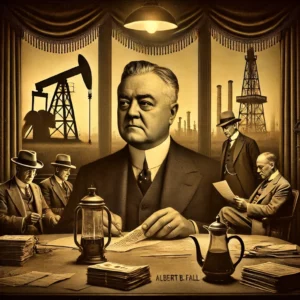The Teapot Dome scandal is a term that has become synonymous with government corruption in the early 1920s. This major political scandal involved the secret leasing of federal oil reserves to private companies in exchange for bribes, which ultimately tarnished the reputation of President Warren G. Harding’s administration. The scandal led to significant legal and political repercussions, highlighting the depths of corruption within the federal government at the time.
The Scandal Unfolds
In 1921, President Warren G. Harding appointed Albert B. Fall as the Secretary of the Interior. Fall, a former senator from New Mexico, was responsible for managing the nation’s natural resources. In a move that would soon become infamous, Fall arranged for the transfer of Navy petroleum reserves at Teapot Dome, Wyoming, and Elk Hills and Buena Vista Hills, California, from the Navy Department to the Department of the Interior.
Without competitive bidding, Fall secretly leased these oil reserves to private oil companies: Teapot Dome to Harry F. Sinclair’s Mammoth Oil Company and the California sites to Edward L. Doheny’s Pan American Petroleum and Transport Company. In exchange, Fall received bribes totaling approximately $400,000 (equivalent to about $6 million today), which were disguised as loans.
Public Outcry and Investigation
The scandal began to unravel in 1922 and 1923 after a series of investigative reports by journalists and subsequent Senate investigations. Suspicion arose due to Fall’s sudden and unexplainable wealth. Senate hearings revealed the extent of the corruption, with evidence showing that Fall had accepted significant sums of money in return for the leases.
Senator Thomas J. Walsh of Montana led the Senate investigation, which became a relentless pursuit of justice. Walsh’s dogged determination paid off as he uncovered the illicit agreements and the substantial bribes Fall had received. The investigation exposed the depth of the scandal to the American public, leading to widespread outrage and demands for accountability.
Outcome and Legacy
In 1929, Albert B. Fall was convicted of accepting bribes and sentenced to one year in prison, making him the first U.S. cabinet member to be incarcerated for crimes committed while in office. The oilmen, Sinclair and Doheny, were acquitted of the charges of bribery and conspiracy, although Sinclair served a brief prison term for contempt of court and jury tampering.
Although President Harding was not directly implicated in the scandal, his administration’s reputation was severely damaged. Harding’s untimely death in 1923 spared him from potential political fallout, but the scandal tainted his legacy. The Teapot Dome scandal remains one of the most significant examples of government corruption in American history, serving as a cautionary tale about the dangers of unchecked power and the importance of transparency and accountability in government.

The Teapot Dome scandal serves as a stark reminder of the potential for corruption within the highest levels of government. The scandal had lasting effects on the American political landscape, leading to increased public scrutiny of government officials and reforms aimed at preventing similar abuses of power in the future. The story of the Teapot Dome scandal is a critical chapter in U.S. history, underscoring the enduring need for vigilance against corruption.
